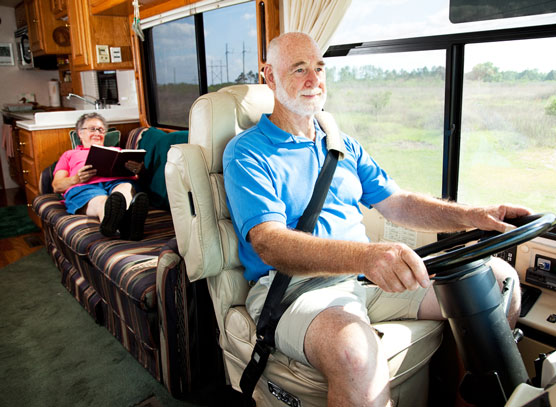Are you a new class A driver ready to embark on your RV life adventure? Driving a Class A motorhome can be an exhilarating experience, but it also comes with its own set of challenges. To help you navigate the roads safely and confidently, here are 10 essential driving tips for new Class A owners.
Familiarize Yourself with Your Vehicle’s Dimensions
Knowing the precise measurements of your Class A motorhome is not just about being detail-oriented; it’s a fundamental aspect of mastering the vehicle. The towering height and broad width, which significantly surpass those of conventional cars, necessitate a keen awareness to navigate through underpasses, tight spots, and alongside other road users without mishaps. Start by committing to memory the height, width, and length of your RV. This knowledge is your first line of defense against potential collisions and will guide you in selecting paths that accommodate your motorhome’s grand scale. Understanding these dimensions deeply impacts your ability to maneuver through scenarios that could otherwise lead to stressful encounters or damage. Engrain this information early on to set the foundation for a smoother, safer journey every time you take the wheel.
Invest Time in Practice Driving
Embarking on the journey as a Class A driver requires not just an understanding of your vehicle’s capabilities but also hands-on, experiential learning. Allocate significant time to practice driving in settings that offer both safety and the space to explore—think expansive, deserted parking lots or secluded roads. This preparatory stage is crucial for familiarizing yourself with the nuances of handling such a sizable vehicle. It’s about building a rapport with your RV, learning how it responds to your commands, and developing a sense of its physical presence on the road. As you guide your motorhome through turns, reverse into parking spaces, and navigate simulated obstacles, you’re not just practicing maneuvers; you’re cultivating confidence and competence. This dedicated practice time is an investment in your safety and enjoyment as you transition into RV life, ensuring that when you do venture onto busier roads, you’re equipped not just with theoretical knowledge, but with practical mastery as well.
Master the Art of Wide Turns
Navigating a Class A motorhome through turns demands a strategy that differs markedly from that of driving a standard vehicle. This process, integral to safe RV life, requires you to take into account the considerable length and pivot points of your vehicle. To adeptly master wide turns, initiate your maneuver by positioning your RV further left (or right, depending on the direction of the turn) than you might intuitively feel is necessary. This preliminary positioning allows your motorhome the ample space it needs to clear obstacles without encroaching on adjacent lanes or curbs. It’s a skill that melds anticipation with execution—visualizing the arc your RV will follow and adjusting accordingly. Perfecting this technique will not only protect your vehicle from unnecessary scrapes but also safeguard pedestrians and other vehicles at intersections. Engage in deliberate practice of this essential maneuver in various driving situations to enhance your spatial awareness and precision, crucial competencies for every Class A driver.
Stay Vigilant About Overhead and Side Clearances
Maintaining constant awareness of the vertical and lateral confines your Class A motorhome operates within is paramount. Your RV’s towering stature means that the usual clearances for cars do not apply to your vehicle. Vigilance is key—look out for and heed the warnings provided by signs indicating the height restrictions of bridges, tunnels, and other overhead structures. Additionally, be mindful of the spaces on either side of your RV, especially when navigating through tight spots or near roadside barriers. This attention to spatial dimensions not only prevents physical damage to your motorhome but also contributes to a safer environment for all road users. This proactive approach to recognizing and respecting overhead and side clearances underscores the essence of responsible RV driving.
Understanding Weight Distribution and Its Effects
The balance of weight within your Class A motorhome plays a pivotal role in ensuring a stable and safe driving experience. Achieving proper weight distribution is about more than just avoiding the tipping of your vehicle; it directly influences handling, braking, and the overall wear on your RV. Strategically loading your RV, with heavier items placed low and centered between the axles, helps maintain an even keel, reducing the risk of sway and enhancing maneuverability. It’s crucial to secure these items to prevent them from shifting while in transit, as movement can significantly alter the center of gravity of your vehicle, potentially leading to dangerous situations, especially in abrupt turns or sudden stops. Regularly assessing how your motorhome is loaded before departure can reveal a lot about how your vehicle handles and responds on the road. Incorporating this practice into your pre-travel routine not only contributes to the longevity of your RV but also to the safety and enjoyment of your adventures on the open road.
Embrace Technology for Navigation and Safety
Leveraging cutting-edge technology can significantly enrich your experience and enhance safety while navigating a Class A motorhome. Opt for an RV-specific GPS system, a tool that’s indispensable for avoiding routes that might present challenges due to your vehicle’s dimensions, such as low-hanging bridges or exceedingly narrow paths. Such systems are tailored to keep you on paths that are conducive to the smooth passage of your motorhome, ensuring that your journey is not just safe but also stress-free. Additionally, integrating a rear-view camera can be a game-changer, offering an extra pair of eyes where it’s most needed. This is especially valuable when maneuvering in reverse or during lane changes, situations that inherently come with blind spots and require acute spatial awareness. These technological aids are not just conveniences; they are essential tools that empower you to make informed decisions, enhancing your overall safety and the enjoyment of your RV life.
Plan Your Route with Your RV in Mind
Embarking on a journey in your Class A motorhome requires thoughtful preparation, particularly in route selection. Opt for thoroughfares that cater to the unique needs of your sizable vehicle. Incorporate RV-friendly amenities into your itinerary, such as spacious campgrounds and accessible fueling stations, which are crucial for a hassle-free experience. Understanding that your motorhome navigates the world differently—more slowly and with greater caution—is essential. It’s not merely about reaching your destination but doing so with your vehicle’s specific requirements at the forefront of your planning. This deliberate approach to trip planning is a testament to your commitment to both safety and the enjoyment of the journey. It ensures that each mile traveled is both feasible and filled with the promise of adventure, tailored perfectly to the rhythm of RV life.
Practice Defensive Driving
Embracing defensive driving is paramount for those steering Class A motorhomes. Vigilance, anticipation, and a conservative approach to distance and speed are your best allies on the road. Given the considerable mass and inertia of your vehicle, reacting to the actions of other drivers and potential hazards requires foresight and ample space. Your motorhome’s extended stopping distances dictate the necessity for heightened alertness and a proactive stance towards navigating the traffic landscape. This strategic driving mindset minimizes risks, ensuring not just your safety but also that of fellow road users. Cultivate these habits to safeguard your adventures, turning challenges into mere bumps on the road to mastery.
Regular Maintenance Checks Are a Must
Ensuring the longevity and safety of your Class A motorhome hinges on a commitment to regular maintenance checks. Before setting off on any journey, a thorough review of your vehicle’s essentials is indispensable. Pay close attention to tire pressure, which can significantly influence handling and fuel efficiency, and regularly inspect fluid levels to prevent engine damage. Brakes, crucial for your safety due to the vehicle’s considerable weight, must be checked for wear and responsiveness. Additionally, a routine examination of lights ensures not only your visibility but also your ability to communicate with other drivers on the road. Establishing a schedule for these inspections, and adhering to it diligently, is a proactive step toward identifying and resolving potential issues before they escalate into more serious problems. Partner with a mechanic skilled in Class A motorhome care to ensure your vehicle remains in optimal condition, ready to take you safely on your next adventure.
Join an RV Community
Immersing yourself within an RV community can dramatically enrich your experience as a new Class A owner. These groups serve as vibrant ecosystems where wisdom, camaraderie, and insights into the nuances of RV life converge. Engaging with fellow enthusiasts, you’ll uncover a treasure trove of practical advice, from the best maintenance practices to hidden gems on the road less traveled. These communities, whether found in physical clubs or vibrant online forums, offer not just guidance but a sense of belonging. Here, your journey is shared, your challenges understood, and your victories celebrated. Leveraging this collective knowledge not only accelerates your learning curve but also deepens your connection to the wider world of RVing, ensuring your adventure is as fulfilling as it is memorable.

